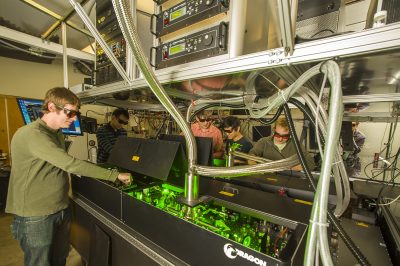
Anna Zarra Aldrich, Office of the Vice President for Research
(Photo: Trallero Lab/Kansas State Photo)
University of Connecticut physics professor Carlos Trallero has been granted $1.06 million from the Department of Defense, the U.S. Air Force and the Air Force Office of Scientific Research to study recollision physics at the nanoscale to help develop ultrafast electronics.
This research will enhance the knowledge base of electron recollision dynamics at the nanoscale, which can be used to develop ultrafast light-driven electronics. These applications may be made possible by cultivating an improved understanding of the interactions and knowledge of the time scales of light-induced electronic motion including collective plasmonic excitations.
Trallero and co-PIs from Kansas State University will study the response of individual gas-phase nanoparticles to intense femtosecond (10-15 seconds) laser fields using high-harmonics spectroscopy, momentum-resolved photoelectron imaging and corresponding theoretical modeling.
Earlier research on photoelectron emission from dielectric and metal nanoparticles has demonstrated that nanoparticles may be a promising system for exploiting the effects of laser-induced electron recollision due to the interplay between the laser field and the near-field of the particle.
By extending these studies to longer wavelengths (400 to 9000 nanometers) and complementing them with high-harmonic generation from nanoparticles and nanoparticle aggregates, Trallero and his team will help build a better knowledge base of electron recollision dynamics at the nanoscale.
“We predict that through this study, we will identify behaviors on the nanoscale that will differ significantly from those that have been studied at the atomic level,” said Trallero.
The UConn-led team will work on the possibilities of controlling the nanoparticle response, especially plasmonic excitations, by applying synthesized two-color fields. They will also explore harmonic generation from tailor-made nanoparticles as a potential source of intense, short-pulsed XUV light.
By generating harmonics from fractal aggregates and supper-lattices of nanoparticles, Trallero will gather information on the transition from localized molecule-like to de-localized solid-like electron-field interactions. The team also plans to study plasmonic excitations in laser pump, X-ray probe experiments using time-resolved soft X-ray scattering.
In collaboration with ultrafast physics faculty, Professors George Gibson and Nora Berrah, Trallero has started planning and building an “Ultrafast Center,” with ties to industry for research that includes an interdisciplinary group of faculty from the department of physics, the Institute of Materials Science, and the Schools of Engineering and Pharmacy. These faculty are specialized in optics, atomic and molecular physics, condensed matter, material science and engineering.
Carlos Trallero, who received his PhD in physics from Stony Brook University in 2007, joined UConn in 2017. His research focuses on attosecond science, strong field molecular spectroscopy, cohere control, higher-order harmonic generation, non-Gaussian optics, strong field science at long wavelengths and ultrafast optics.
This research is funding under DOD project number FA9550-17-1-0369.
